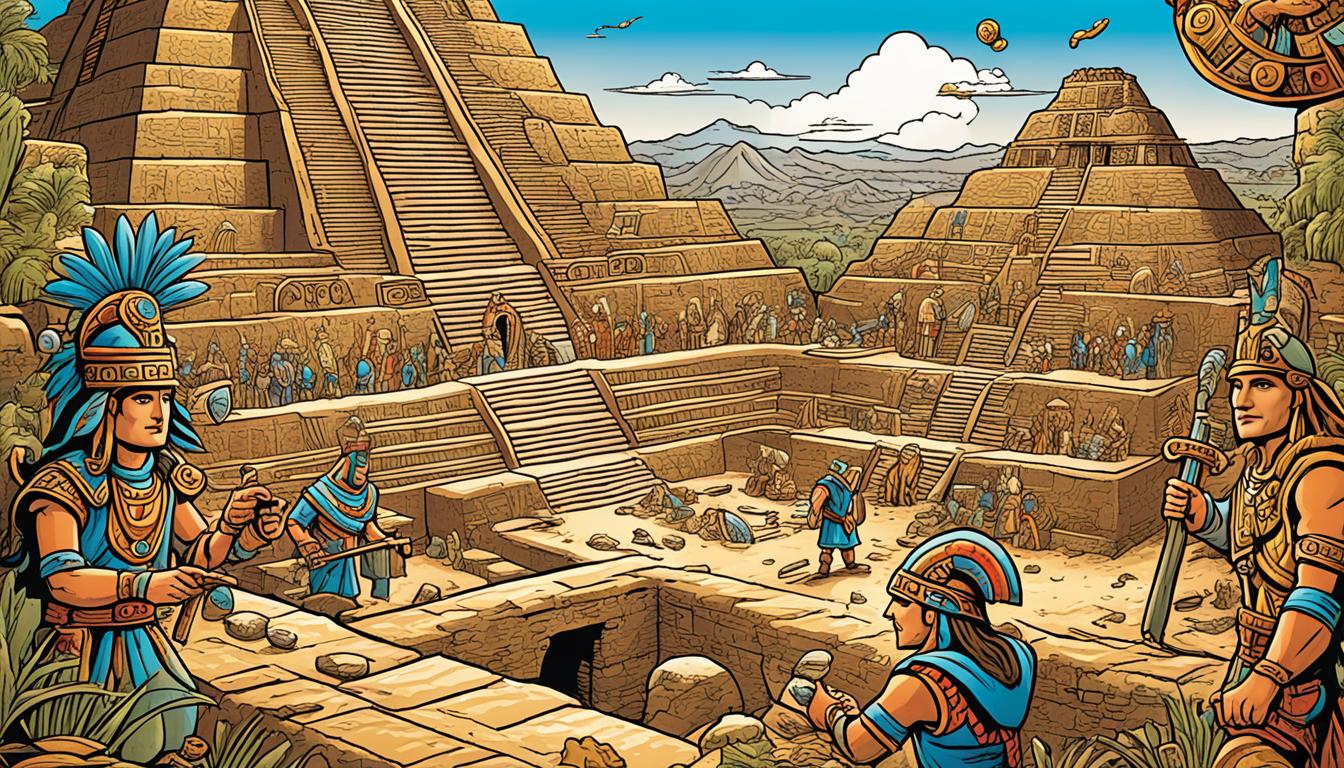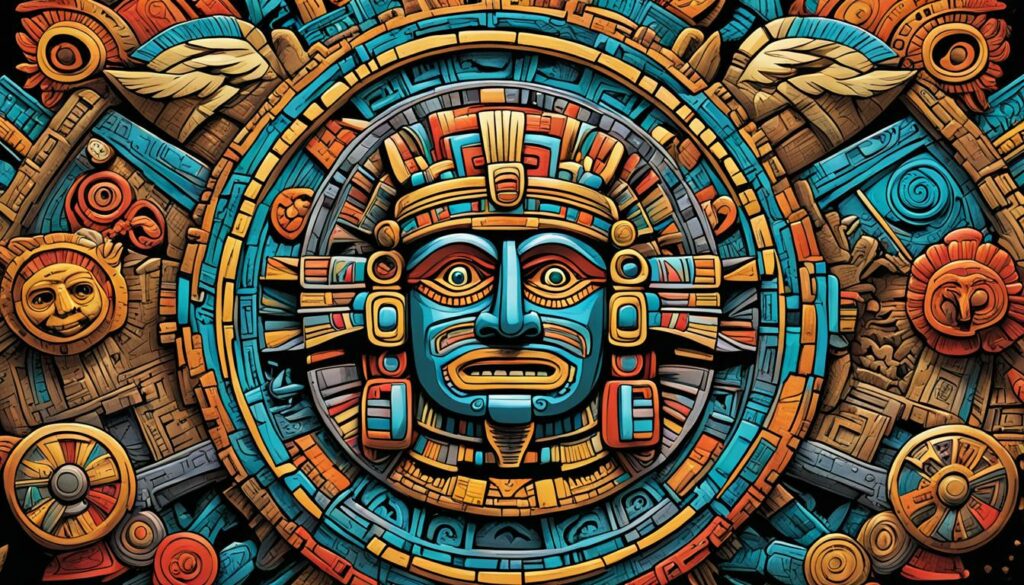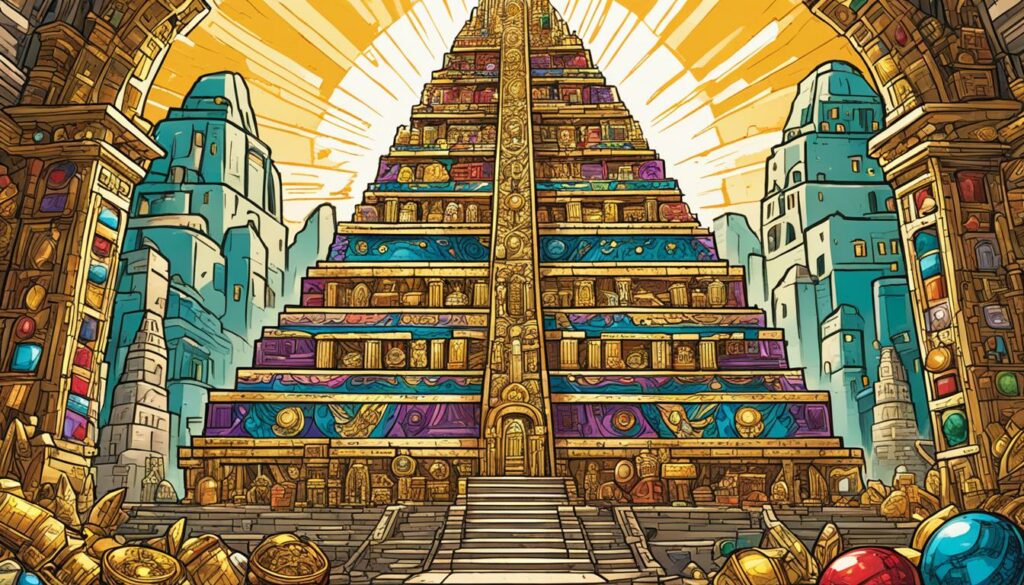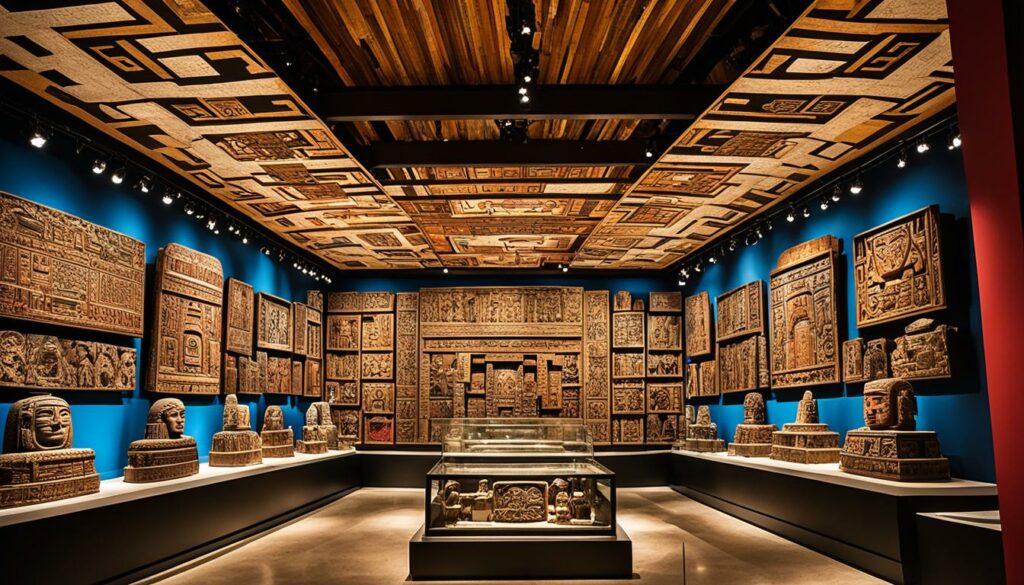
Welcome to a captivating journey into the world of the Aztec civilization, where each artifact holds a story of cultural wealth and historical significance. The Aztecs were a remarkable civilization with a deep appreciation for beauty and craftsmanship. From stunning artworks to shimmering gold treasures, their legacy continues to captivate us today. Join us as we uncover the treasures of the Aztecs and delve into the secrets they hold.
Key Takeaways:
- The Aztec civilization left behind a treasure trove of artifacts and relics that showcase their rich culture.
- Artifacts unearthed from Aztec sites display incredible craftsmanship and artistic skills.
- Gleaming gold treasures were highly valued by the Aztecs and symbolized their love for wealth.
- Archaeological finds provide insights into the customs, rituals, and daily life of the Aztec people.
- The treasures of the Aztec civilization have significant historical importance and contribute to our understanding of their rise and fall.
Aztec Culture: A Brief Overview
Before we delve into the treasures of the Aztec civilization, it is essential to gain a deeper understanding of their rich culture and the profound significance of the relics they left behind. The Aztecs were a vibrant and highly advanced civilization that thrived in ancient Mexico from the 14th to the 16th century. Their culture was deeply rooted in religious beliefs, elaborate rituals, and a reverence for nature.
At the heart of Aztec culture lay a ceremonious worldview that permeated every aspect of their society. They believed in a complex pantheon of gods and goddesses, with Huitzilopochtli, the god of the sun and war, holding a central position. The Aztecs organized their society into different strata, with powerful rulers, skilled artisans, and dedicated priests occupying esteemed positions.
The Aztecs were renowned for their architectural masterpieces, such as majestic temples, palaces, and other monumental structures. One of the most impressive examples of their architectural prowess is the Templo Mayor, a magnificent pyramid-like structure in the heart of Tenochtitlan, the Aztec capital. This religious center served as the focal point for rituals, sacrifices, and other ceremonies that formed the core of Aztec religious practices.
“The Aztecs had a profound respect for the natural world, often attributing divine qualities to animals and plants. Their reverence for nature is evident not only in their spiritual rituals but also in their exquisite art and craftsmanship.”
Aztec art and craftsmanship are celebrated for their intricate detail, vibrant colors, and symbolic representations. The Aztecs excelled in various art forms, including sculpture, pottery, jewelry, and featherwork. They created awe-inspiring pieces that embodied both beauty and cultural significance. Aztec artisans and craftsmen were highly skilled, utilizing precious materials such as jade, turquoise, obsidian, and gold to create magnificent pieces that reflected their advanced artistic capabilities.
The Aztecs’ devotion to their gods and their desire to honor them with precious offerings led to the accumulation of a significant treasure trove in the form of ceremonial objects. These treasures consisted of intricately designed gold and silver ornaments, feathered headdresses, symbolic sculptures, and intricately painted codices that served as religious texts and historical records.
The Aztec civilization was a flourishing society that left behind a rich legacy, encompassing both material treasures and intangible cultural expressions. Understanding their culture is crucial to appreciating the value and significance of the treasures they left behind.
The Importance of Aztec Culture:
- Aztec culture treasures the interconnectedness between humanity, nature, and the divine.
- Their art and craftsmanship reflect their advanced skills and aesthetic sensibilities.
- Aztec culture treasures the oral and written traditions passed down through generations.
- Their architectural achievements showcase their engineering prowess and religious devotion.
- Aztec culture treasures the wisdom and knowledge embedded in their rituals and customs.
By delving into the rich Aztec culture, we gain a deeper appreciation for the significance and value of the mesmerizing treasures that have survived the test of time.
Majestic Artifacts: Masterpieces from the Aztec Empire
As we journey through the remnants of the Aztec civilization, we are captivated by the breathtaking beauty and craftsmanship of the ancient Aztec artifacts. These treasures unearthed from the Aztec sites give us a glimpse into the rich cultural and artistic heritage of this remarkable empire.
The ancient Aztec artifacts, meticulously crafted by skilled artisans, are a testament to the sophistication and ingenuity of this civilization. From intricately carved stone sculptures to ornate gold jewelry, every piece tells a story of the Aztec’s reverence for art and their deep connection to nature and spirituality.
“The creativity and attention to detail evident in these artifacts are truly awe-inspiring. Each piece showcases the mastery of the Aztec artisans and their ability to capture the essence of their beliefs and traditions.”
One standout example of ancient Aztec artifacts is the iconic Sun Stone, also known as the Aztec Calendar Stone. This monumental sculpture, approximately 12 feet in diameter, features intricate carvings depicting cosmological and mythological symbols. It serves as a symbolic representation of the Aztec’s complex understanding of time and celestial cycles.
Another remarkable artifact is the Olmec-style mask, adorned with jade and gold. This exquisite piece exemplifies the Aztec’s fascination with precious materials and their meticulous attention to detail. The mask’s intricate carvings reflect the religious and ceremonial significance it held within the Aztec society.

Notable Ancient Aztec Artifacts
| Artifact | Description |
|---|---|
| Tlaloc Vessel | An intricately painted ceramic vessel depicting Tlaloc, the Aztec god of rain and fertility. |
| Xiuhcoatl | A ceremonial fire serpent made of copper and adorned with turquoise, symbolizing the Aztec’s dedication to fire worship. |
| Feathered Serpent | A feathered serpent sculpture, representing Quetzalcoatl, one of the most revered Aztec deities. |
| Eagle Warrior Figurine | A small figurine made of copper and depicting an eagle warrior in traditional Aztec attire, representing bravery and strength. |
These ancient Aztec artifacts, preserved for centuries, continue to astound archaeologists and historians. They offer invaluable insights into the daily lives, beliefs, and aspirations of the Aztec people. With each discovery, we deepen our understanding of this remarkable civilization and the indelible mark they left on history.
Gleaming Gold Treasures: Aztec’s Love for Wealth
The Aztecs, known for their opulent culture and rich traditions, held a deep appreciation for the allure of precious metals. Amongst all treasures, gold occupied a special place in their society, symbolizing power, prestige, and divine connections. Let’s journey into the world of the Aztecs and discover the significance of their gleaming gold treasures.
The Aztec civilization revered gold for its brilliance and rarity, considering it a divine substance that could bridge the mortal world with the realm of the gods. The mastery of extracting, refining, and crafting gold was a testament to their advanced metallurgical techniques, which allowed the creation of intricate and extravagant artifacts.
From exquisite jewelry adorned with intricate designs to ceremonial masks embellished with gold, the Aztecs used this precious metal to elevate their status and express their devotion to deities. Gold ornaments, such as necklaces, bracelets, and rings, were crafted with meticulous care, reflecting the intricate motifs and symbolism prevalent in Aztec art.
Evidence of the Aztecs’ reverence for gold can be found in the artifacts discovered at archeological sites throughout Mesoamerica. The magnificent gold offerings that were buried alongside rulers and nobles demonstrate the Aztecs’ belief in the afterlife and the importance of wealth in the journey beyond.
“Gold was a symbol of divinity among the Aztecs, and its use in ceremonial objects and rituals exemplified their spiritual connection.”
The Aztecs’ obsession with gold went beyond the realm of personal adornment. Gold was also used in the creation of intricate sculpture and architecture, elevating their temples and palaces to grandeur and splendor. The iconic Templo Mayor, the centerpiece of the Aztec capital of Tenochtitlan, featured gold-plated elements that shimmered in the sun, further emphasizing their devotion to both the physical and spiritual aspects of gold.
It is through the discovery of these gleaming gold treasures that we gain valuable insights into the Aztecs’ social structure, religious practices, and cultural values. Each artifact tells a story, encapsulating the aspirations, beliefs, and ambitions of a civilization that marveled in the beauty and power of gold.
| Gold Treasures | Description |
|---|---|
|
1.
|
El Códice del Oro
|
|
2.
|
Penacho de Moctezuma
|
|
3.
|
Tlaloc Vessel
|
|
4.
|
Gold Eagle Warrior
|
|
5.
|
Offering of Tizoc
|
The Glittering Legacy
Despite the ravages of time and the conquests of the Spanish conquistadors, the glittering legacy of the Aztec gold treasures endures. They not only serve as a testament to the incredible wealth and artistic finesse of the Aztec civilization but also as a reminder of the complex and vibrant culture that once thrived in Mesoamerica.
Join us in the next section as we delve deeper into the archaeological finds that have shed light on the customs and rituals of the Aztec civilization, unearthing more secrets and treasures beneath the surface.

Unveiling Aztec Archaeological Finds
Embark on a thrilling journey as we unveil some of the most fascinating aztec archaeological finds, providing invaluable insights into the customs, rituals, and way of life of the ancient Aztec civilization. These remarkable discoveries shed light on the rich cultural tapestry woven by this extraordinary society.
The Temple of the Feathered Serpent
One of the most astounding aztec archaeological finds is the Temple of the Feathered Serpent, also known as the Temple of Quetzalcoatl. Located in the city of Teotihuacan, this iconic structure is adorned with impressive carvings depicting the feathered serpent deity, a prominent figure in Aztec mythology.
“The Temple of the Feathered Serpent represents the seamless blending of art and spirituality in Aztec culture.” – Dr. Elena Garcia, Archaeologist
Excavations at the site have unearthed numerous serpent-themed artifacts, including intricately carved stone statues and precious offerings buried alongside human remains. These aztec archaeological finds not only testify to the Aztecs’ deep reverence for Quetzalcoatl but also provide valuable clues about their religious practices.
The Great Aztec Sun Stone
No exploration of aztec archaeological finds would be complete without mentioning the Great Aztec Sun Stone, a mesmerizing masterpiece of ancient Aztec artistry. This monumental stone disk, weighing over twenty-four tons, is adorned with intricate engravings depicting the Aztec creation myth and celestial events.
“The Great Aztec Sun Stone is a testament to the advanced scientific knowledge and astronomical expertise of the Aztecs.” – Dr. Alejandro Ramirez, Historian
Discovered in the heart of Mexico City, this awe-inspiring artifact offers a glimpse into the Aztecs’ understanding of the cosmos and their innovative calendar system. Its intricate carvings and symbolism showcase the ingenuity and artistic vision of this remarkable civilization.
Aztec Codices: Windows into the Past
The preservation of written records was of utmost importance to the Aztecs, who developed elaborate codices to document their history, rituals, and traditions. These ancient manuscripts, made of bark paper, provide valuable insights into the daily lives and beliefs of the Aztec people.
- Florentine Codex: A comprehensive encyclopedia of Aztec civilization, compiled by Friar Bernardino de Sahagun
- Grolier Codex: A fragmentary Maya-Aztec book, one of the rarest and oldest surviving Mesoamerican manuscripts
- Codex Borbonicus: A divinatory almanac containing intricate illustrations and detailed information about the Aztec calendar and rituals
These aztec archaeological finds serve as windows into the past, allowing us to appreciate the cultural richness and intellectual achievements of the Aztec civilization.
Aztec Ceramic Figurines: A Glimpse into Daily Life
Delicate and meticulously crafted, Aztec ceramic figurines provide a glimpse into the daily life of the Aztec people. These miniature works of art depict scenes from agriculture, fishing, weaving, and other aspects of their society.

One such figurine portrays a market scene, with merchants bartering goods and customers examining their wares. These aztec archaeological finds offer valuable insights into the economy, social structure, and trade network of the Aztec civilization.
| Artifact | Location | Significance |
|---|---|---|
| Aztec Sun Stone | Mexico City | Depicts cycles of creation, destruction, and cosmic order |
| Codex Borbonicus | Mexico City | Provides insights into the Aztec calendar and rituals |
| Temple of the Feathered Serpent | Teotihuacan | Symbolizes Quetzalcoatl and Aztec religious beliefs |
These aztec archaeological finds highlight the diversity and complexity of the Aztec civilization, leaving us in awe of their achievements and inspiring further exploration of their magnificent legacy.
Historical Significance: The Legacy of Aztec Treasures
Aztec treasures hold immense historical significance, providing us with valuable insights into the rise and fall of this ancient civilization. These artifacts, discovered and preserved over centuries, offer a window into the fascinating world of the Aztecs and their cultural, social, and economic practices.
From intricately crafted jewelry to meticulously carved sculptures, the treasures of the Aztec civilization showcase their exceptional craftsmanship and artistic prowess. They reflect the beliefs, traditions, and values of the Aztec people, allowing us to comprehend their way of life with greater clarity.
One of the most renowned examples of Aztec treasures is the Feathered Serpent Pyramid in Teotihuacan. This architectural marvel displays the incredible engineering skills of the Aztecs and demonstrates their reverence for deities such as Quetzalcoatl, the Feathered Serpent god.
These treasures also serve as tangible links to the Aztec’s love for wealth and their masterful use of gold. Gold was highly valued in the Aztec empire for its aesthetic appeal and association with the divine. The abundance of gleaming gold treasures discovered in Aztec tombs and royal palaces exemplifies the empire’s opulence and prosperity.
Furthermore, Aztec archaeological finds have revealed ceremonial objects and religious artifacts, presenting a deeper understanding of their religious practices and rituals. These discoveries shed light on the grandeur and sacred nature of Aztec ceremonies, showcasing their dedication to their gods and the spiritual realm.
Aztec treasures not only hold historical significance but also contribute to our modern-day knowledge and research. Their study allows historians, archaeologists, and anthropologists to piece together the puzzle of the past, constructing a comprehensive narrative of the Aztec civilization. Through careful examination and analysis, researchers gain valuable insights into Aztec society, governance, trade networks, and artistic expressions.
The Impact on Modern Understanding
Studying Aztec treasures opens doors to a deeper comprehension of human history, cultural diversity, and the interconnectedness of civilizations. The legacy of the Aztec treasures goes beyond their material value; it extends to our understanding of ancient societies, their achievements, and their triumphs.
Exploring the Aztec treasures is like deciphering a lost language. Each artifact is a word, a phrase, or a story waiting to be understood, woven into the fabric of our shared human narrative.
By appreciating the historical significance of Aztec treasures, we gain a greater appreciation for the diversity and ingenuity of humanity throughout the ages. These artifacts serve as a testament to the resilience and creativity of the Aztec people, whose contributions continue to inspire and captivate us today.
As we continue our exploration of the wonders of ancient civilizations, we embark on a journey through time, uncovering the treasures of the Aztec civilization and deepening our understanding of their rich and complex legacy.
Conclusion
As we reach the end of our journey into the treasures of the Aztec civilization, we have immersed ourselves in a world of cultural wonders and historical significance. From the cultural riches that are a testament to the creativity and skill of the Aztec people to the majestic artifacts that showcase their mastery in craftsmanship, each discovery has unveiled a piece of their extraordinary legacy.
Among the treasures, the gleaming gold artifacts stand as a symbol of the Aztec’s love for wealth and their mastery in metalwork. These valuable relics not only signify their economic prosperity but also provide insights into their social hierarchy and religious beliefs.
Through the exploration of archaeological finds, we have gained a deeper understanding of the customs, rituals, and way of life of the Aztec civilization. The excavation of ancient sites has offered a window into their daily lives, shedding light on their farming practices, urban planning, and reverence for nature.
The significance of Aztec treasures cannot be overstated. Not only do they provide a tangible connection to the past, but they also shape our understanding of one of the most influential civilizations in history. By studying and preserving these treasures, we continue to unlock the secrets of the Aztec empire and appreciate their extraordinary accomplishments.
Join us again for more adventures into the wonders of ancient civilizations, as we dive into the riches left behind by other fascinating cultures around the world.
